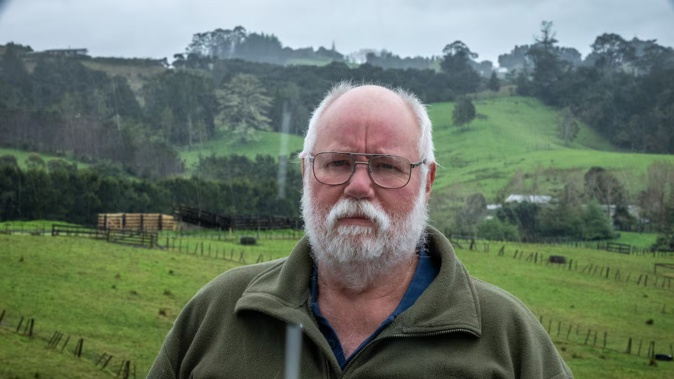
An Auckland couple say a makeshift abattoir that began operating next door has turned 25 years of peaceful rural living into regular scenes of distress and “carnage”.
Dairy Flat homeowner Kevin Bell said an abattoir-on-wheels now rolled into the next-door paddock most weeks to kill a small number of his neighbour’s sheep and cattle.
Bell said he wanted answers about how a “commercial slaughterhouse” could be set up so close to his Blackbridge Rd home and in view of his lounge window.
Auckland Council and the Ministry for Primary Industries (MPI) confirmed they had each received a complaint and were looking into the matter.
Bell said he didn’t pay council rates on his $1.8 million, 4ha property “to look at an abattoir”.
“Now I get to watch 300-plus animals killed 6m outside my boundary each year.”
Neighbour David Taylor said the number of slaughtered animals was more likely to be about 100 annually.
Taylor said he’d tried to minimise disruption by offering to build an embankment to shield the operation from Bell’s view but that his offer was rebuffed.
The truck visiting Taylor’s property is understood to be the first of its kind in New Zealand.
If the model takes off, the pair’s clash could be the first of more backyard abattoir stoushes elsewhere in the country.
Farm-to-table: Will mobile abattoirs become more common?
Truck owner Logan Wait, who started company Earth First, said he was working with NZ Food Safety with the aim of rolling the model out widely.
It needed to first prove to MPI the operations were safe.
His truck had been travelling from Hawke’s Bay to Northland to test the concept, with the Herald reporting in August how it was being used at Kaipara’s Danbri Farm to produce a new premium meat brand.
Taylor was also one of a handful farmers licensed to harvest and sell his own meat directly to the public.
Kevin Bell says he wants answers on how a "commercial slaughterhouse" could be set up on his boundary fence. Photo / Michael Craig
He said he was hiring the mobile truck to kill about three to four of his own animals each fortnight for sale at his Dairy Flat shop, The Local Farmer Butchery.
The concept had great support from customers, he said.
“Everyone’s getting right behind it.
“They’re buying local – they’re buying animals that are farmed just up the road from where they live, which people seem to like.”
It was also opening new opportunities for farmers by “cutting the big boys out … the supermarkets have held us all over a barrel for so long”.
Supporters of the model also say avoiding trucking animals to big abattoirs reduced stress and improved their meat.
The whole thing is quite disturbing: Bell
However, Bell believed the stress was being transferred on to his family and his own sheep and cattle.
“The whole thing is quite disturbing to be honest – my wife doesn’t enjoy seeing it happening and neither do I.
“My stock walking up and down my land watching their brethren being killed on the other side of the fence isn’t cheering anybody up either.”
The operation occurs about 150m-200m from Bell’s window but close to his property’s boundary.
Races are used to move animals into position to be killed behind screens, with the meat kept inside the covered truck.
Bell claimed he could hear the “rifle shot” used to kill animals as well as the noise of generators.
He said he had also seen offal and other waste being put into rubbish bins and worried blood could be draining into waterways.
Wait and Taylor said they had licences to operate and that each kill was dictated by a registered risk management programme that included having a veterinarian or meat inspectors present.

The mobile abattoir also visits Danbri Farm in the Kaipara, where a family-run regenerative property uses it to create a premium Angus beef brand. Photo / Michael Craig
Given the model was a new one, Wait and Taylor said they were keen to work with neighbours like Bell to make improvements.
Taylor said he’d “bent over backwards” to help Bell in the past, including helping slaughter some of Bell’s own animals and helping him do things such as drench his stock.
He also offered to build the embankment so the operation would be shielded from sight.
He claimed Bell told him he’d consider the offer before Bell texted back to say he’d see Taylor in court.
‘Looking into the matter’: MPI and Auckland Council
NZ Food Safety deputy director-general Vincent Arbuckle said his team had received a complaint about whether the operation was “meeting the necessary rules around slaughter”.
“We have spoken with the complainant and are looking at the information provided and requesting further details,” he said.
All food producers must be registered and meet food safety requirements to ensure what they produce is fit for humans to consume.
MPI rules stated mobile abattoirs did not necessarily need resource consents from local councils to operate but that could depend on how the operations affected the environment.
A photo taken by Kevin Bell of the mobile abattoir in operation on the neighbouring property on Blackbridge Rd, Dairy Flat. Photo / Supplied
Auckland Council compliance manager Adrian Wilson said resource consents had not been sought to operate a micro-abattoir at the Blackbridge Rd property.
“An issue has been raised with the council relating to the slaughter of animals and the [potential] fluid run-off into a stormwater drain and nearby stream,” he said.
“This matter is under investigation by the council’s compliance team.”
Taylor and Wait said they were working with MPI and council closely to answer all questions about the operation.
They believed the mobile abattoir was a promising business model for small farmers.
But Bell, meanwhile, said he’d keep fighting to stop “this carnage in front of my home”.
Take your Radio, Podcasts and Music with you









